The Human Body in Traditional Chinese Medicine (TCM)
In the first article of the series, we discussed the differences between Western Oriental Medicine and how Traditional Chinese Medicine (TCM) was a form of holistic medicine, since it focused on healing the physical and non-physical aspects of the human condition. In the second article, we discussed how Taoism sets the intellectual foundation for understanding TCM.
Unsurprisingly, Traditional Chinese Medicine views the body as having physical and non-physical components. Knowing what these non-physical components are is important to understanding how the human body is viewed in TCM, which in turn sets the foundation for understanding TCM notions of health, illness, and treatments. As such, in this article we will give an overview of the TCM model of the human body, which is taught alongside Western anatomy at our acupuncture school in Florida.
Two Important Philosophical Paradigms of Traditional Chinese Medicine
Perhaps the two most important Taoist ideas in Traditional Chinese Medicine are Yin-Yang and Wu Xing.
Yin-Yang: Just as reductionism forms the basis for Western medicine, the Taoist concept of Yin-Yang forms the paradigm for Traditional Chinese Medicine. Yin-yang, which translates into “dark-bright,” describes the idea that everything in nature consists of two paradoxical phases or energies.
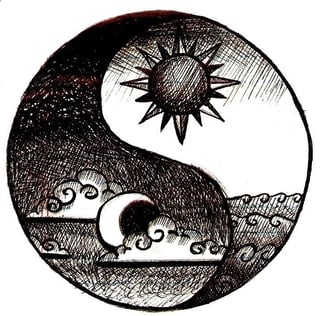
Taoist philosophy holds that yin-yang is inherit in everything
The dual relationship of Yin and Yang is meant to demonstrate that everything in the universe exists as having connected and complementary, yet polar-opposite elements. The table below demonstrates many of these relationships.

In other words, everything is made up of yin and yang. In terms of the human body, yin is associated with the lower parts of the body, while yang is associated with the upper body and back.
Wu Xing: Wu Xing, also known as the Five Phases or Five Elements, is the Taoist notion that the cyclical change of the cosmos occurs in a pattern of five stages.
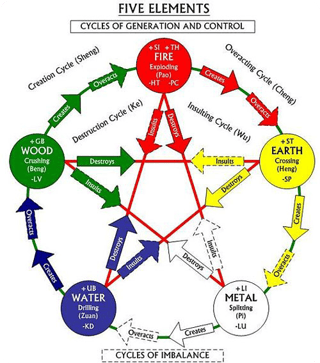
Wu Xing is important across all areas of Oriental Medicine
Using the classical Chinese description of the seasons as an example, Wu Xing demonstrates that Spring gives rise to Early Summer, which turns into Late Summer, which then becomes Fall, then Winter, and then Spring again. The table below shows some common examples of Wu Xing cycles.

Wu Xing is an extremely important concept in Traditional Chinese Medicine, because it is used for understanding Zang-Fu, the interconnected penta-cycle of organs that process qi (chi) in the body. The Zang-Fu is discussed in greater detail in this article.
The Three Major Functional Entities
Traditional Chinese Medicine maintains a holistic view of the body. Rather than being a strictly physical specimen, the body is viewed as being composed of physical and non-physical substances.
However, in contrast to Western medicine, TCM puts less emphases on anatomical structures and more on its unique system of non-physical attributes collectively known as the three major Functional Entities.
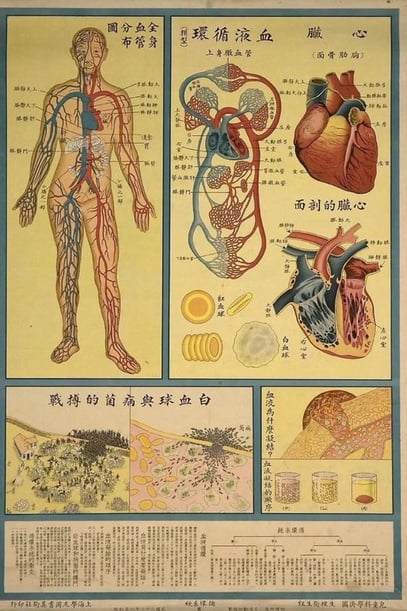
Organs in TCM are viewed by their function, not physical makeup
It is these three major functional entities that give us the Traditional Chinese Medical (TCM) model of the body, and are used to determine health, illnesses, and used to diagnose illnesses and prescribe treatments.
The three major functional entities in TCM are:
- The Five Fundamental Substances: Qi or chi, Xue (Blood), Jinye (Body Fluids), Jing (Essence), and Shen (Spirit).
- Zang-fu: A Wu Xing cycle of 5 zang organs, 6 fu organs, and their functions
- Jing-luo: The channels or meridians through which qi flows
Each of the functional entities is associated with one of five cardinal functions, which describes the role that they play in maintaining health.
The Five Cardinal Functions in TCM are:
- Actuation–Locomotion of all the physical processes in the body. This is especially true of blood and qi
- Warming–Regulation of temperature, especially that of the limbs.
- Defense– Protection against foreign pathogenic elements
- Containment–Preventing excessive drainage of different body fluids
- Transformation–Converting foods, liquid, and breath into qi, blood, and other jinye
As such, the functional entities should be viewed as practical roles, rather than strictly anatomical or biochemical functions. The functional entities are all interconnected.
Five Vital Substances: In TCM, qi (chi) is the vital energy that gives rise to life. It manifests in five major forms collectively referred to as the Five Vital Substances or Five Fundamental Substances. They are:
- Qi (chi): The core life force that is responsible for bodily functions, including of metabolism, digestion, as well as performing the five cardinal functions. Yang in nature.
- Xue: The blood substance that nourishes and refreshes the body and mind. Yin in nature.
- Jinye: The body fluids that provide moisture and lubrication necessary for normal body functions. Yin in nature.
- Jing: Essence that is responsible for all bodily growth and development. Yin in nature.
- Shen: Mind or spirit substance of the body and that is responsible for perception, thought, and understanding. Yang in nature.
Zang-fu: As mentioned above, the organs of the body are interconnected in a We Xing cycle known as Zang-fu.
Zang refers to organs that are yin in nature. They are the pericardium, heart, liver, spleen, lung, and kidneys.
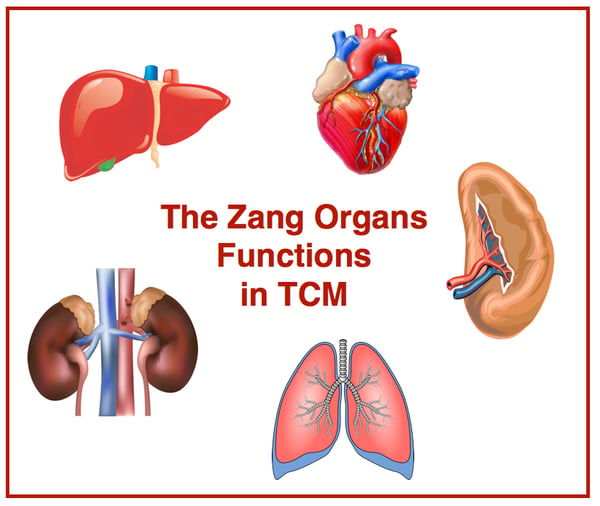
Fu refers to organs that are yang. They are the triple burner, small intestine, large intestine, gallbladder, urinary bladder, and stomach.
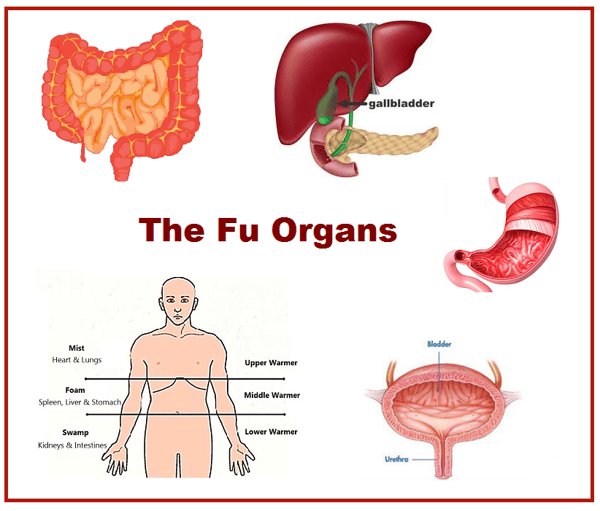
Each zang has a fu, and every zang-fu pair corresponds to one of the five phases. The chart below shows this relationship.

Jing-luo: Each of the Zung-fu pairs has 12 Jing-luo or major pathways where qi, blood, and body fluids flow through, known as the 12 Principal Meridians. They run from the Zung-fu organs to the limbs and joints. There are 8 extraordinary meridians, which connects the 12 Principal Meridians. From these 20 meridians, extends a network of nearly 400 points!
The numerous meridians and acupoints are visually represented in the famous acupuncture models that many are familiar with.
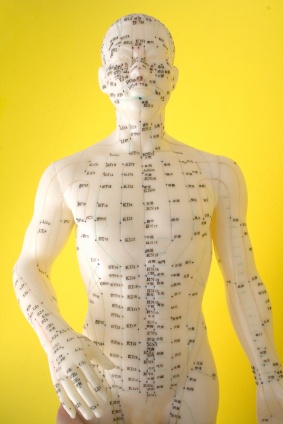 An exact replica of models used in our Miami classrooms
An exact replica of models used in our Miami classrooms
The relationship between yin-yang, Wu Xing, functional entities, and the meridians can be complex and difficult to understand at first. However, in the coming weeks, we will expand and discuss these holistic concepts in greater detail.
So far, we have assumed a balanced or ziran state of the functional entities. What happens when yin-yang or qi levels become unbalanced? Coming up, we will discuss the Traditional Chinese Medical view of health and illness, and TCM methods for diagnosis.
If you find this blog series interesting, then perhaps you should consider a career in Acupuncture and Oriental Medicine.
Download our free acupuncture career guide below or call our admissions office in Miami, FL at (305)-595-9500 to learn more about our Florida acupuncture school. If you're ever in the area, feel free to give us a visit. Acupuncture and Massage College is located at 10506 N Kendall Drive, Miami, FL 33176.
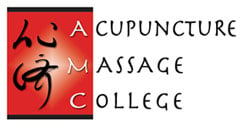
 (305) 595-9500
(305) 595-9500







